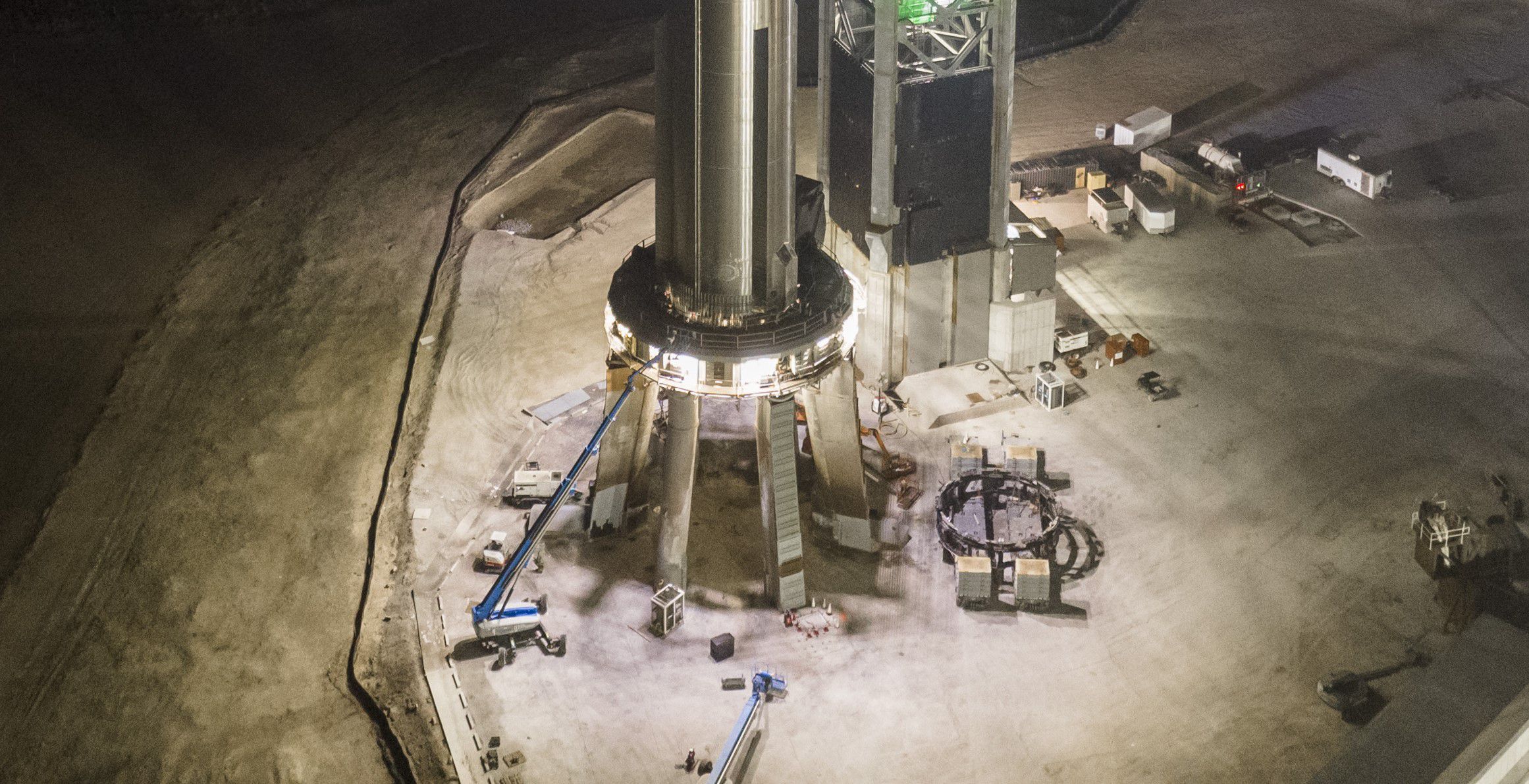
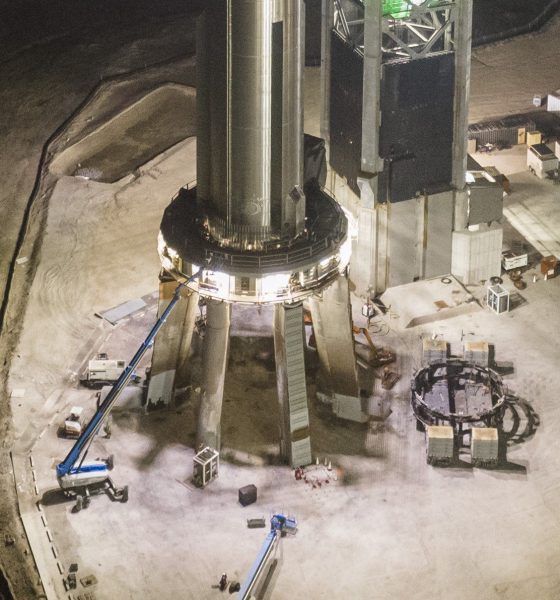
News
SpaceX to ship Starship ‘deluge’ hardware from Florida to Starbase
SpaceX appears to be preparing to ship a huge collection of hardware – including parts of a possible launch deluge system – from Florida to Texas.
Captured live by NASASpaceflight’s 24/7 Space Coast Live webcam, hardware began accumulating at NASA’s Kennedy Space Center (KSC) Turning Basin on January 12th. Within a few days, four midsize storage tanks, two or three large storage tanks, five high-pressure gas tanks, multiple sections of an apparent launch deluge system, and an unfinished Starship booster transport stand were all staged and ready for shipment. Save for implicit statements from reliable sources, there wasn’t an obvious guarantee that the hardware was all SpaceX’s or headed to the company’s Starbase, Texas factory and launch site.
But combined with the sheer volume of hardware and its privileged presence on NASA KSC property, the last part to arrive – the base of an unmistakable Starship (booster) transport stand – all but confirmed that the destination is Starbase. SpaceX has already shipped hardware from Florida to Starbase multiple times, including a trio of tanks sent in October 2022, which further increases the odds that everything visible is destined for Starbase.
The update that's rolling out to the fleet makes full use of the front and rear steering travel to minimize turning circle. In this case a reduction of 1.6 feet just over the air— Wes (@wmorrill3) April 16, 2024
It might also not be a coincidence that in its first attempt to build a Starship launch site at Kennedy Space Center, SpaceX installed four midsize tanks and plenty of high-pressure gas tanks at LC-39A. The resurgence of work on a totally different Starship pad design at 39A in late 2021 likely made that hardware redundant. It’s possible that the four smaller tanks set to be shipped to Starbase originated at 39A and are being moved in the hopes that they can be more useful elsewhere.
Additionally, satellite photos taken on January 3rd, 2023 and shared by Harry Stranger show a pair of larger tanks also sitting unused at Pad 39A. Ultimately, it’s almost certain that the delivery is SpaceX hardware bound for Starbase, Texas.
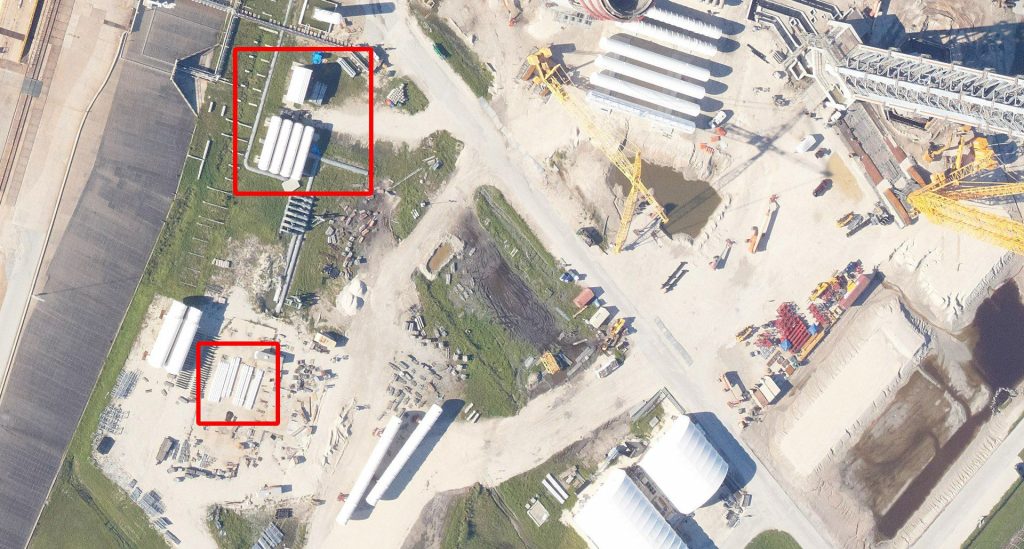
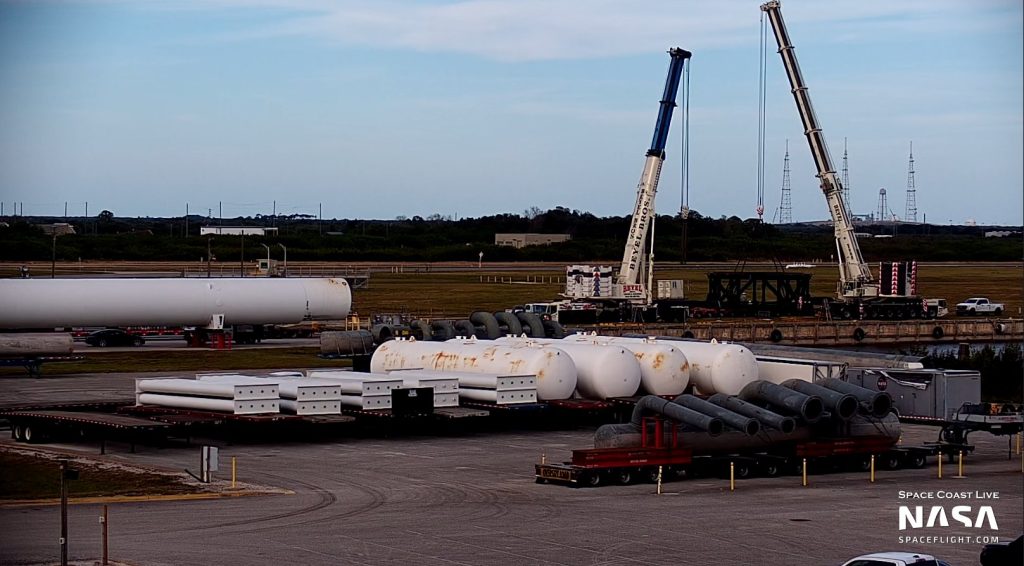
A deluge? Under my Starship?
The most interesting part of the shipment is arguably a group of giant metal tubes. Measuring several feet wide, dozens of feet long, and fitted with multiple outlets connected to the same giant pipe, the likeliest possible explanation is that the manifolds are part of a plan to upgrade SpaceX’s Texas Starship launch site with a deluge system.
Almost all rockets use some sort of deluge system to prevent their own exhaust from damaging or destroying themselves or their surroundings. A large volume of water sprayed into the space just below a rocket’s engines can prevent the immense acoustic energy (sound) they produce from wreaking havoc. A deluge also helps protect launch pad hardware by allowing some of the energy in the exhaust to boil and vaporize water instead of eating into concrete or steel. But CEO Elon Musk has infamously stated that SpaceX is intentionally attempting to build an orbital launch site that doesn’t need a flame diverter for Starship – the most powerful rocket in history.
That’s gone about as well as one might expect. Even Starship, which can produce about 18% as much thrust as Super Heavy, has repeatedly incinerated the concrete beneath its test stand, spreading molten debris for thousands of feet and starting major brush fires in a nature reserve. After every six-engine Starship static fire, SpaceX must painstakingly remove and replace all of the concrete beneath the test stand.
The problem is even more apparent at Starbase’s orbital launch mount, where SpaceX has begun to conduct Super Heavy booster static fire tests. Thus far, SpaceX has had to replace the concrete under the OLM after almost every Super Heavy static fire – a process that takes a week or two. The company recently replaced that concrete with a mix optimized to survive high temperatures, but it remains to be seen if that will survive a direct blow from the most powerful rocket in history.
For the time being, Starbase’s environmental permit only allows up to five orbital launches per year, making lengthy post-launch repairs mostly inconsequential. However, if SpaceX ever wants Starbase to rapidly launch multiple Starships back to back – essential for in-space refilling – or launch dozens of Starships per year, it’s become clear that a deluge system is likely essential.
Starship’s Florida deluge
Some part of SpaceX knows that. The design of Starship’s first Florida launch pad has already been upgraded to include a giant deluge ring embedded in the ground at the base of the mount. Unusual design aside, the structure is sized such that it’s almost certainly a high-flow deluge system capable of spraying thousands of gallons of water per second.
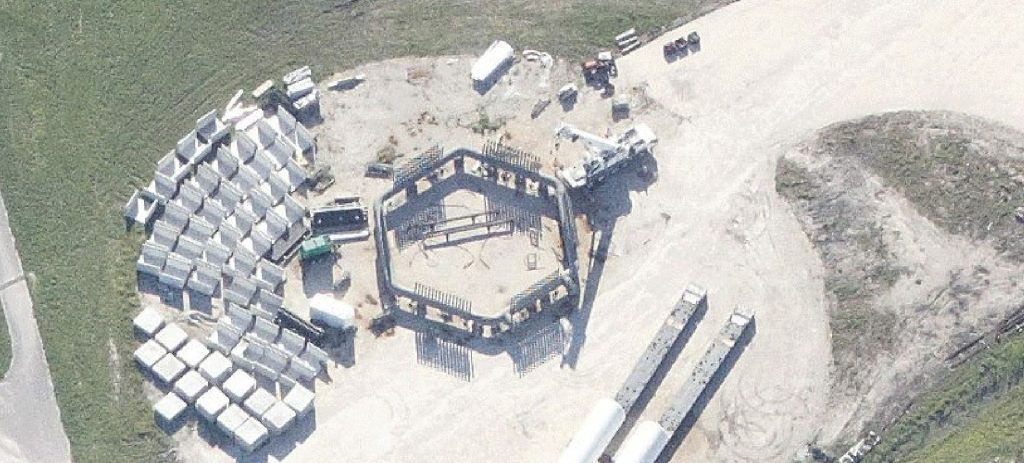
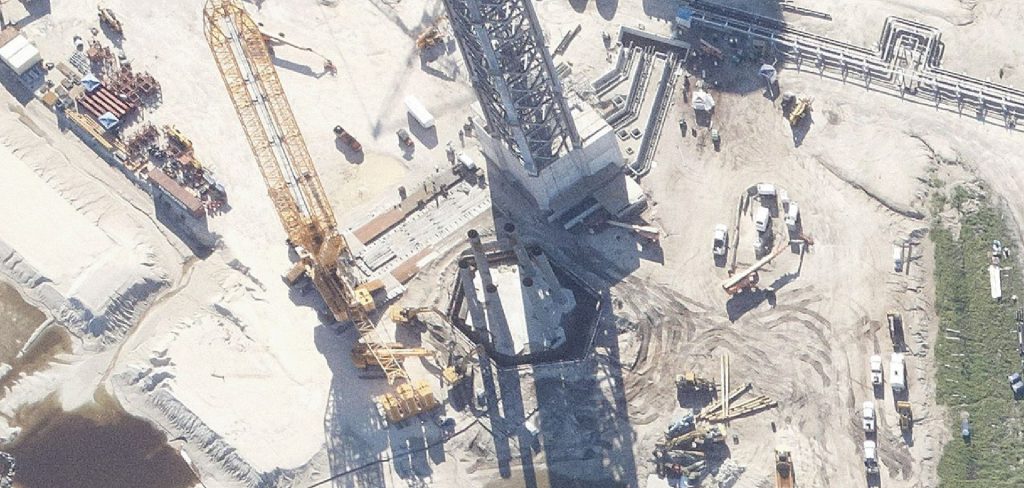
Three months later, SpaceX appears to be preparing to ship two giant deluge manifolds and some deluge plumbing from Florida to Starbase. If SpaceX intends to retrofit Starbase’s existing orbital launch site with a giant deluge system, the process would likely take months and render the pad more or less unusable from start to finish. Alternatively, Musk recently reported that SpaceX intends to build a “rocket test facility” at a separate property it purchased in South Texas. Located miles from the Starbase launch pad, the former gun range could potentially allow SpaceX to test Starships and Super Heavy boosters without disrupting orbital launch preparations and taking over Starbase’s only orbital launch mount.
Perhaps it’s not a coincidence that the same site – currently used for storage and limited Starship tank testing – already hosts some smaller parts of a potential Starbase deluge system. Regardless, it’s clear that significant changes are coming to Starbase and its associated facilities.

Elon Musk
Elon Musk’s X will start using a Tesla-like software update strategy
The initiative seems designed to accelerate updates to the social media platform, while maintaining maximum transparency.

Elon Musk’s social media platform X will adopt a Tesla-esque approach to software updates for its algorithm.
The initiative seems designed to accelerate updates to the social media platform, while maintaining maximum transparency.
X’s updates to its updates
As per Musk in a post on X, the social media company will be making a new algorithm to determine what organic and advertising posts are recommended to users. These updates would then be repeated every four weeks.
“We will make the new 𝕏 algorithm, including all code used to determine what organic and advertising posts are recommended to users, open source in 7 days. This will be repeated every 4 weeks, with comprehensive developer notes, to help you understand what changed,” Musk wrote in his post.
The initiative somewhat mirrors Tesla’s over-the-air update model, where vehicle software is regularly refined and pushed to users with detailed release notes. This should allow users to better understand the details of X’s every update and foster a healthy feedback loop for the social media platform.
xAI and X
X, formerly Twitter, has been acquired by Elon Musk’s artificial intelligence startup, xAI last year. Since then, xAI has seen a rapid rise in valuation. Following the company’s the company’s upsized $20 billion Series E funding round, estimates now suggest that xAI is worth tens about $230 to $235 billion. That’s several times larger than Tesla when Elon Musk received his controversial 2018 CEO Performance Award.
As per xAI, the Series E funding round attracted a diverse group of investors, including Valor Equity Partners, Stepstone Group, Fidelity Management & Research Company, Qatar Investment Authority, MGX, and Baron Capital Group, among others. Strategic partners NVIDIA and Cisco Investments also continued support for building the world’s largest GPU clusters.
News
Tesla FSD Supervised wins MotorTrend’s Best Driver Assistance Award
The decision marks a notable reversal for the publication from prior years, with judges citing major real-world improvements that pushed Tesla’s latest FSD software ahead of every competing ADAS system.

Tesla’s Full Self-Driving (Supervised) system has been named the best driver-assistance technology on the market, earning top honors at the 2026 MotorTrend Best Tech Awards.
The decision marks a notable reversal for the publication from prior years, with judges citing major real-world improvements that pushed Tesla’s latest FSD software ahead of every competing ADAS system. And it wasn’t even close.
MotorTrend reverses course
MotorTrend awarded Tesla FSD (Supervised) its 2026 Best Tech Driver Assistance title after extensive testing of the latest v14 software. The publication acknowledged that it had previously criticized earlier versions of FSD for erratic behavior and near-miss incidents, ultimately favoring rivals such as GM’s Super Cruise in earlier evaluations.
According to MotorTrend, the newest iteration of FSD resolved many of those shortcomings. Testers said v14 showed far smoother behavior in complex urban scenarios, including unprotected left turns, traffic circles, emergency vehicles, and dense city streets. While the system still requires constant driver supervision, judges concluded that no other advanced driver-assistance system currently matches its breadth of capability.
Unlike rival systems that rely on combinations of cameras, radar, lidar, and mapped highways, Tesla’s FSD operates using a camera-only approach and is capable of driving on city streets, rural roads, and freeways. MotorTrend stated that pure utility, the ability to handle nearly all road types, ultimately separated FSD from competitors like Ford BlueCruise, GM Super Cruise, and BMW’s Highway Assistant.
High cost and high capability
MotorTrend also addressed FSD’s pricing, which remains significantly higher than rival systems. Tesla currently charges $8,000 for a one-time purchase or $99 per month for a subscription, compared with far lower upfront and subscription costs from other automakers. The publication noted that the premium is justified given FSD’s unmatched scope and continuous software evolution.
Safety remained a central focus of the evaluation. While testers reported collision-free operation over thousands of miles, they noted ongoing concerns around FSD’s configurable driving modes, including options that allow aggressive driving and speeds beyond posted limits. MotorTrend emphasized that, like all Level 2 systems, FSD still depends on a fully attentive human driver at all times.
Despite those caveats, the publication concluded that Tesla’s rapid software progress fundamentally reshaped the competitive landscape. For drivers seeking the most capable hands-on driver-assistance system available today, MotorTrend concluded Tesla FSD (Supervised) now stands alone at the top.
News
Elon Musk’s Grokipedia surges to 5.6M articles, almost 79% of English Wikipedia
The explosive growth marks a major milestone for the AI-powered online encyclopedia, which was launched by Elon Musk’s xAI just months ago.

Elon Musk’s Grokipedia has grown to an impressive 5,615,201 articles as of today, closing in on 79% of the English Wikipedia’s current total of 7,119,376 articles.
The explosive growth marks a major milestone for the AI-powered online encyclopedia, which was launched by Elon Musk’s xAI just months ago. Needless to say, it would only be a matter of time before Grokipedia exceeds English Wikipedia in sheer volume.
Grokipedia’s rapid growth
xAI’s vision for Grokipedia emphasizes neutrality, while Grok’s reasoning capabilities allow for fast drafting and fact-checking. When Elon Musk announced the initiative in late September 2025, he noted that Grokipedia would be an improvement to Wikipedia because it would be designed to avoid bias.
At the time, Musk noted that Grokipedia “is a necessary step towards the xAI goal of understanding the Universe.”
Grokipedia was launched in late October, and while xAI was careful to list it only as Version 0.1 at the time, the online encyclopedia immediately earned praise. Wikipedia co-founder Larry Sanger highlighted the project’s innovative approach, noting how it leverages AI to fill knowledge gaps and enable rapid updates. Netizens also observed how Grokipedia tends to present articles in a more objective manner compared to Wikipedia, which is edited by humans.
Elon Musk’s ambitious plans
With 5,615,201 total articles, Grokipedia has now grown to almost 79% of English Wikipedia’s article base. This is incredibly quick, though Grokipedia remains text-only for now. xAI, for its part, has now updated the online encyclopedia’s iteration to v0.2.
Elon Musk has shared bold ideas for Grokipedia, including sending a record of the entire knowledge base to space as part of xAI’s mission to preserve and expand human understanding. At some point, Musk stated that Grokipedia will be renamed to Encyclopedia Galactica, and it will be sent to the cosmos.
“When Grokipedia is good enough (long way to go), we will change the name to Encyclopedia Galactica. It will be an open source distillation of all knowledge, including audio, images and video. Join xAI to help build the sci-fi version of the Library of Alexandria!” Musk wrote, adding in a later post that “Copies will be etched in stone and sent to the Moon, Mars and beyond. This time, it will not be lost.”








